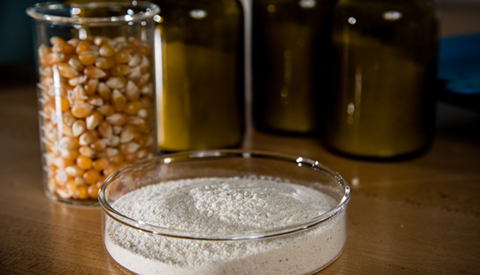
The newest reference material from NIST will enable detection of many types of toxins in corn, known as mycotoxins.
Scientists at the National Institute of Standards and Technology (NIST) have developed a new reference material that can be used to identify deadly toxins in corn products. The material is described in a new journal paper and will be available for purchase in July. Known as Standard Reference Material 1565 or SRM 1565, this new product can be used by lab scientists who need a reliable way to measure corn for poisonous compounds that are produced by mold, known as mycotoxins.
Mycotoxins are naturally occurring and often form when grains and cereals are stored in areas of high humidity. They also show up in some field settings, where crops like rye and wheat are grown. They are fairly common and can cause economic losses for farmers and food producers if left undetected and allowed to spread.
Not all molds produce mycotoxins, but when they occur the impact on consumers can be intense. Humans who ingest mycotoxins often develop flu-like symptoms such as inflammation of the sinuses, fatigue, frequent coughing, skin rashes and headaches. Some mycotoxins can cause vomiting. In extreme cases, mycotoxins can even be deadly. They enter the bodies of people who eat moldy cereals and grains, or drink milk from cows that have eaten mycotoxin-exposed feed.
Although earlier reference materials could identify individual strains, the new SRM is remarkable in that it can identify 12 of the mycotoxins that occur in corn crops and corn products.
“This reference material can be used to check for different types of these toxins, which means labs can get more testing done in a shorter time,” says Melissa Phillips, who leads the team that developed the new SRM.
Mycotoxins, she adds, are a challenge to food producers all over the world. “In all economies, people want to be able to examine the crops they’ve grown. People want to be confident in the safety of their food.”
To make the material, Phillips and her team, including collaborators from the U.S. Food and Drug Administration, gathered corn products from various sources, including regional labs and grocery stores. They blended together contaminated samples with uncontaminated products from store shelves to produce a powdered SRM that has levels of mycotoxins approximately equal to regulatory limits already in place for the toxic compounds.
The food safety research team at NIST plans to develop similar SRMs for mycotoxins in other products. This fall, the group is also planning a wide-ranging international workshop on food safety that will include sessions on the importance of mycotoxin identification.
Paper: M. Phillips, T. López Seal, J.M. Ness, and K. Zhang. Development and Characterization of a Multimycotoxin Reference Material. Journal of AOAC International. Available online June 17, 2019. DOI: 10.5740/jaoacint.19-0109

